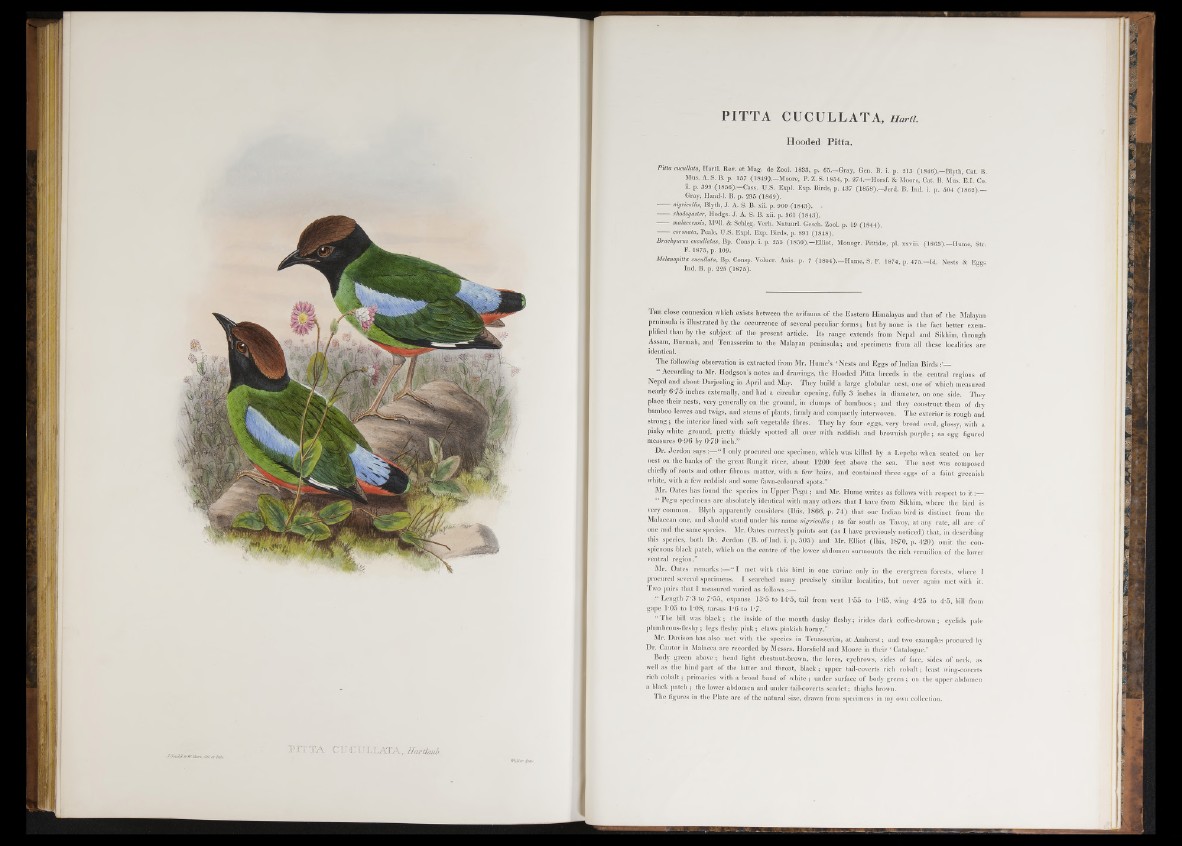
PITTA CUCULLATA, Harti.
Hooded P itta .
Pitta cuculiata, H a rtl. Rev. e t Mag. de Zool. 1833, p. 65.—Gray, Gen. B. i. p. 213 (1846).—Blyth, Cat. B.
Mus. A. S. B. p. 167 (1849).—Moore, P. Z. S. 1854, p. 274.—Horsf. & Moore, Cat. B. Mus. E .I. Co.
. ii . p. 399 (1856).—Cass. U.S. Expl. Exp. Birds, p. 437 (1858).—Jerd . B. Ind. i. p . 504 (1862).—
Gray, Hand-1. B. p. 295 (1869).
nigricollis, Blyth, J . A. S. B. xii. p. 960 (1843). -
rhodogaster, Hodgs. J . A. S. B. xii. p. 961 (1843).
malaccensis, Mull. & Schleg. Verh. Natuurl. Gesch. Zool. p . 19 (1844).
coronata, Peale, U.S. Expl. Exp. B irds, p. 891 (1848).
Brachyurus cucullatus, Bp. Consp. i. p. 255 (1850).—Elliot, Monogr. Pittidse, pi. xxviii. (1863).—Hume, Str
F. 1875, p. 109.
Melanopitta cuculiata, Bp. Consp. Volucr. 'A nis. p. 7 (1854).—Hume, S. F. 1874, p. 475.—Id. Nests & Eggs
Ind. B. p. 225 (1875).
T h e close connexion which exists between the avifauna of the Eastern Himalayas and that of the Malayan
peninsula is illustrated by the occurrence of several peculiar forms; but by none is the fact better exemplified
than by the subject o f the present article. Its range extends from Nepal and Sikhim, through
Assam, Burmah, and Tenasserim to the Malayan peninsula; and specimens from all these localities are
identical.
The following observation is extracted from Mr. Hume’s ‘ Nests and Eggs o f Indian B i r d s __
“ According to Mr. Hodgson’s notes and drawings, the Hooded Pitta breeds in the central regions of
Nepal and about Darjeeling in April and May. They build a large globular nest, one o f which measured
nearly 6 7 5 inches externally, and had a circular opening, fully 3 inches in diameter, on one side. They
place their nests, very generally on the ground, in clumps of bamboos ; and they construct them of drv
bamboo leaves and twigs, and stems of plants, firmly and compactly interwoven. The exterior is rough and
stro n g ; the interior lined with soft vegetable fibres. They lay four eggs, very broad oval, glossy, with a
pinky white ground, pretty thickly spotted all over with reddish and brownish pu rp le; an egg figured
measures 0 ’96 by 0 7 9 inch.”
Dr. Jerdon says I only procured one specimen, which was killed by a Lepcha when seated on her
nest on the banks o f the great Rungit river, about 1200 feet above the sea. The nest was composed
chiefly of roots and other fibrous matter, with a few ‘hairs, and contained three eggs of a faint greenish
white, with a few reddish and some fawn-coloured spots.”
Mr. Oates has found the species in Upper P e g u ; and Mr. Hume writes as follows with respect to it
“ Pegu specimens are absolutely identical with many others that I have from Sikhim, where the bird is
very common. Blyth apparently considers (Ibis, 1866, p. 74) that our Indian bird is distinct from the
Malaccan one, and should stand under his name nigricoUis; as far south as Tavoy, at any rate, all are of
one and the same species. Mr. Oates correctly points out (as I have previously noticed) that, in describing
this species, both Dr. Jerdon (B. of Ind. i. p. 505) and Mr. Elliot (Ibis, 1870, p. 420) omit the conspicuous
black patch, which on the centre o f the lower abdomen surmounts the rich vermilion of the lower
ventral region.”
Mr. Oates remarks: “ I met with this bird in one ravine only in the evergreen forests, where I
procured several specimens. I searched many precisely similar localities, but never again met with it.
Two pairs that I measured varied as follows:—-
“ Length 7 3 to 7-55, expanse 13*5 to 14-5, tail from vent 1*55 to 1-65, wing 4-25 to 4-5, bill from
gape 1*05 to 1*08, tarsus l -6 to 1 7 .
“ The bill was black ; the inside of the mouth dusky fleshy; irides dark coffee-brown; eyelids pale
plumbeous-fleshy; legs fleshy pin k ; claws pinkish horny.”
Mr. Davison has also met with the species in Tenasserim, a t Amherst; and two examples procured by
Dr. Cantor in Malacca are recorded by Messrs. Horsfield and Moore in their ‘ Catalogue.’
Body green above; head light chestnut-brown, the lores, eyebrows, sides o f face, sides of neck, as
well as the hind part of the latter and throat, black; upper tail-coverts rich co b alt; least wing-coverts
rich cobalt; primaries with a broad band of white ; under surface o f body green ; on the upper abdomen
a black patch ; the lower abdomen and under tail-coverts scarlet; thighs brown.
The figures in the Plate are of the natural size, drawn from specimens in my own collection.